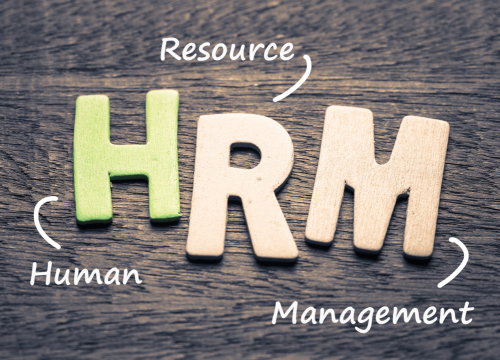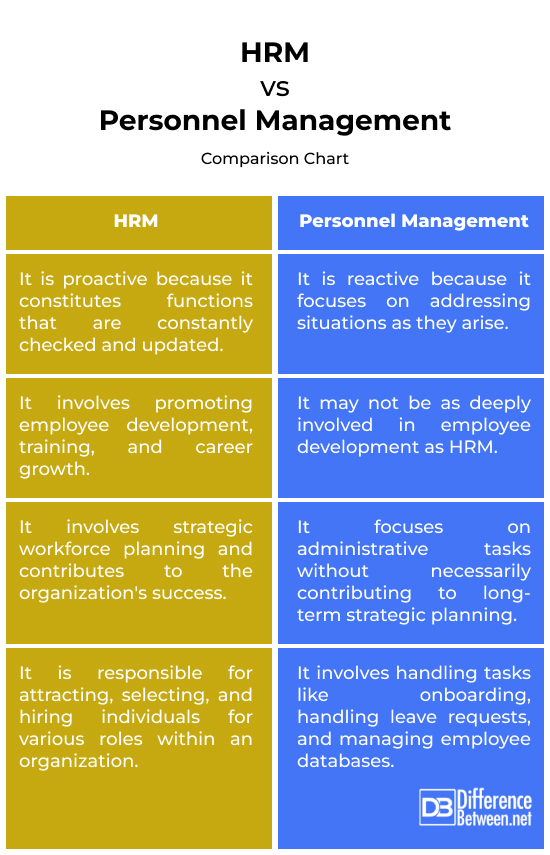Difference Between HRM and Personnel Management
Human resource management (HRM) and people management are both extremely important aspects of managing an organization’s workforce. A more strategic approach is taken by human resource management (HRM), which involves integrating the management of human resources with the broader strategic goals of the firm. In contrast, personnel management is typically more concerned with administrative and routine responsibilities than other types of management.
Within the context of the contemporary workplace, the phrases human resource management (HRM) and personnel management are frequently used interchangeably. However, there are some small distinctions between the two of them. Stay with us, and we will explain them in ways that are easy to understand.

What is HRM?
Managing a company’s human resources, also known as HRM, is an intelligent and comprehensive approach to managing the most crucial aspect of a business: its employees. Figuring out what the employees require in order to improve the efficiency of the organization is what it signifies. HRM ensures that the way in which the company interacts with its employees is in line with the overarching objectives of the entire organization. You could think of it as ensuring that everyone is on the same page.
When it comes to human resource management, it’s similar to making sure that your organization hires the correct people for the various positions it has available. This entails making a plan for the number of people you require, determining the requirements for each position, and locating effective methods for recruiting new members for the team.
Here are some important things HRM does:
- Helps employees learn and get better at their jobs through training and other learning opportunities.
- Sets up ways to understand how well employees are doing, gives feedback, and helps them improve.
- Handles problems and makes sure everyone is treated fairly, and encourages everyone to talk openly.
- Plans and manages how employees get paid and what other benefits they get.
- Makes sure the company follows the rules about how the employees should be treated, like labor laws and ethical standards.

What is personnel management?
Personnel management is primarily concerned with the routine activities that are involved in the administration of an organization’s staff. Among these responsibilities are the monitoring of their records, the verification that they are paid appropriately, and the resolution of any problems that may arise. When you do this, you are essentially taking care of the fundamentals without having to worry too much about the bigger picture of the entire organization.
Key features of personnel management include:
- Handling paperwork and records for employees, making sure everyone gets paid correctly.
- Handling workplace issues by listening to both sides, finding solutions, and ensuring everyone follows company rules.
- Ensuring the company complies with labor laws, regulations, and internal policies.
- Onboarding, handling leave requests, and managing employee databases.
Difference between HRM and Personnel Management
Focus
The Human Resource Management (HRM) approach is both proactive and strategic, with the purpose of matching the organization’s human resource practices with its broader strategic goals. Management of personnel, on the other hand, is concerned with day-to-day activities and immediate personnel requirements, but it does not necessarily correspond closely with the overarching strategy of the business.
Development of Staff Members
In order to ensure the long-term success of the firm, human resource management (HRM) provides employees with opportunities to advance their careers through various training and development programs. Personnel management, on the other hand, is typically concerned with day-to-day activities such as paperwork, employee perks, and routine personnel transactions.
Approach
By taking into account the entirety of the employee lifecycle, from recruiting to retirement or exit, human resource management (HRM) adopts a holistic approach to managing people. Nevertheless, people management follows a traditional approach and concentrates on immediate human needs and administrative responsibilities, without necessarily contributing to long-term strategic planning. This is because personnel management is a conventional approach.
Relationships with Employees and Participation
Through the promotion of open communication, human resource management seeks to promote a positive working environment. Making the workplace a joyful atmosphere, ensuring that everyone is content, and encouraging open communication are the goals. Although personnel management is also concerned with employee relations, it may have a tendency to take a more traditional approach, with the primary goals being the maintenance of positive relationships and the resolution of problems.
HRM vs. Personnel Management: Comparison Chart

Summary
Both “personnel management” and “human resource management” were terms that were used in the past to differentiate between administrative and strategic approaches to management. Remembering this fact is absolutely necessary at all times. However, in modern usage, these expressions are regularly interchanged with one another. This is a common occurrence. When it comes to managing their personnel, the vast majority of organizations, on the other hand, possess a level of intelligence that allows them to integrate administrative and strategic approaches.
FAQs
What is the difference between HR management and people management?
HR management encompasses strategic functions like:
- Talent acquisition and retention
- Policy development and compliance
- Employee relations
- Training and development
People management involves:
- Motivating and engaging employees
- Delegating tasks and managing performance
- Supporting individual growth and performance
- Maintaining positive team dynamics
What is the difference between human resource management and HRM?
There is a common usage of the abbreviation “HRM” to refer to “Human Resource Management.” The meanings are not significantly different from one another.
What is the difference between HRM and personnel management Quora?
It was believed that personnel management was a more transactional and administrative approach, with an emphasis on activities such as record-keeping, payroll, and compliance.
On the other hand, human resource management takes a people-centered approach. It places an emphasis on employee engagement, professional growth, and the creation of a happy working environment since it views employees as important assets.
What do personnel management and HRM have in common?
- Management of an organization’s staff is the focus of both of these.
- Both are responsible for responsibilities such as record-keeping, payroll, and recruitment.
- In both cases, the goal is to guarantee that labor rules and regulations are followed.
What is personnel management in HRM?
Personnel management functions still exist within HRM but are often integrated into a broader framework with a greater emphasis on employee well-being, development, and strategic alignment.
- Difference Between Caucus and Primary - June 18, 2024
- Difference Between PPO and POS - May 30, 2024
- Difference Between RFID and NFC - May 28, 2024
Search DifferenceBetween.net :
26 Comments
Leave a Response
References :
[0]Image credit: https://www.canva.com/photos/MADF9lTqJ-M-hrm/
[1]Image credit: https://www.canva.com/photos/MAFQz3I6cTs-a-group-of-people-attracts-people-around-to-join-collaboration-and-cooperation-growth-of-a-critical-mass-of-citizens-business-personnel-management-and-outsourcing-involvement-in-a-project/
[2]Köster, Marco. Human Resource Management Versus Personnel Management. GRIN Verlag, 2007.
[3]Bach, Stepehen. Managing Human Resources: Personnel Management in Transition. John Wiley & Sons, 2009.
[4]Barney, Nick. “Human Resource Management (HRM).” TechTarget, www.techtarget.com/searchhrsoftware/definition/human-resource-management-HRM. Accessed 28 Jan. 2024.

i think this is a good site 4 know all about the topic thanks 4 help me ……..
keep smyling
I like the difference and understands it very well ,thank u sooooo much .its a very useful site .
This site would be my favorite coz i get virtually everything i need in it.
Thank you so much for your assistence it means alot
THANKS FOR UR HELP…..THOUGH I DONT’T HAVE SPARE TIME BUT U DESERVE IT…THANKKKKKKKKSSS
You have made my day thank you so much for the answers
seriously, this site is helping the managers and even d students on their research and even course work…
this is the next great master thank u so much
Prabhat sir excellent job sir
This is awesome, thanks
nice answers, really thanks
thanks i like it very much, and like the differences and understand it very clearly.
It is the most useful site for student or managers thank you so much for maker’s site.
Thanks, nice answers.
Excellent answers. May God reward you for your efforts.
thanks
Thanks for the answers
Really,it is soo much helpful to me:-) each n everything define in very gud manner .thankuu
Kudos you re doing good
Thanks that was very helpful
Very useful information.
Many thanks
the information was very useful thanks alot
I am glad with ur articles and found all beneficial for research and projects.
I heard by requesting you a help of all relevant note and documents you feel is urtentic to my course Bsc in faculty of management science in four course in the award of Bachelor degree in procument
It’s a fact that I was one of the people who was failing to understand the distinction between Human Resource Management and the Personnel Management. But the these things have been articulated, I can now see how different these two are.
Thank so much
Henry.
Helpful